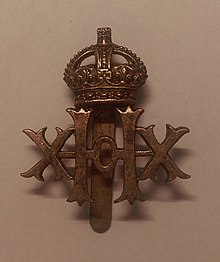20th Hussars
| 20th Hussars | |
|---|---|

Badge of the 20th Hussars
|
|
| Active | 1862–1922 |
| Country |
|
| Branch |
|
| Type | Cavalry |
| Role | Line Cavalry |
| Size | One Regiment |
| Nickname(s) | Nobody's Own |
The 20th Hussars was a cavalry regiment of the British Army. After service in the First World War it was amalgamated with the 14th King's Hussars to form became the 14th/20th King's Hussars in 1922.
The regiment was originally raised in Bengal by the East India Company as the 2nd Bengal European Light Cavalry in 1858, for service in the response to the Indian Rebellion. It was renamed the 2nd Bengal European Cavalry in 1859 and in 1862, while based in Mathura, it was transferred to the British Army and renamed the 20th Regiment of Hussars. It became the 20th Hussars in 1877.
The regiment remained on the North West Frontier and participated in the Ambela Campaign in autumn 1863 and the Hazara Expedition in October 1868 before moving to England in 1872. The regiment was based in Ireland from 1879 to 1884.
The regiment was sent to Sudan as part of the Suakin Expedition in February 1885 and took part in the Battle of Tofrek in March 1885 and the Battle of Ginnis in December 1885. It also took part in the Battle of Gemeizeh in December 1888 during the Mahdist War when it made a series of charges against the enemy. In this battle, three of the swords of the 20th Hussars broke short, an incident which later caused debate in the House of Commons. It undertook another successful charge at the Battle of Toski in August 1889. After their return to England in 1890, the regiment was awarded the battle honour "Suakin 1885" for its services in Egypt and also the battle honour "Vimiera" in respect of the earlier services of its predecessor regiment, the 20th Light Dragoons. The regiment return to India in 1895.
...
Wikipedia
